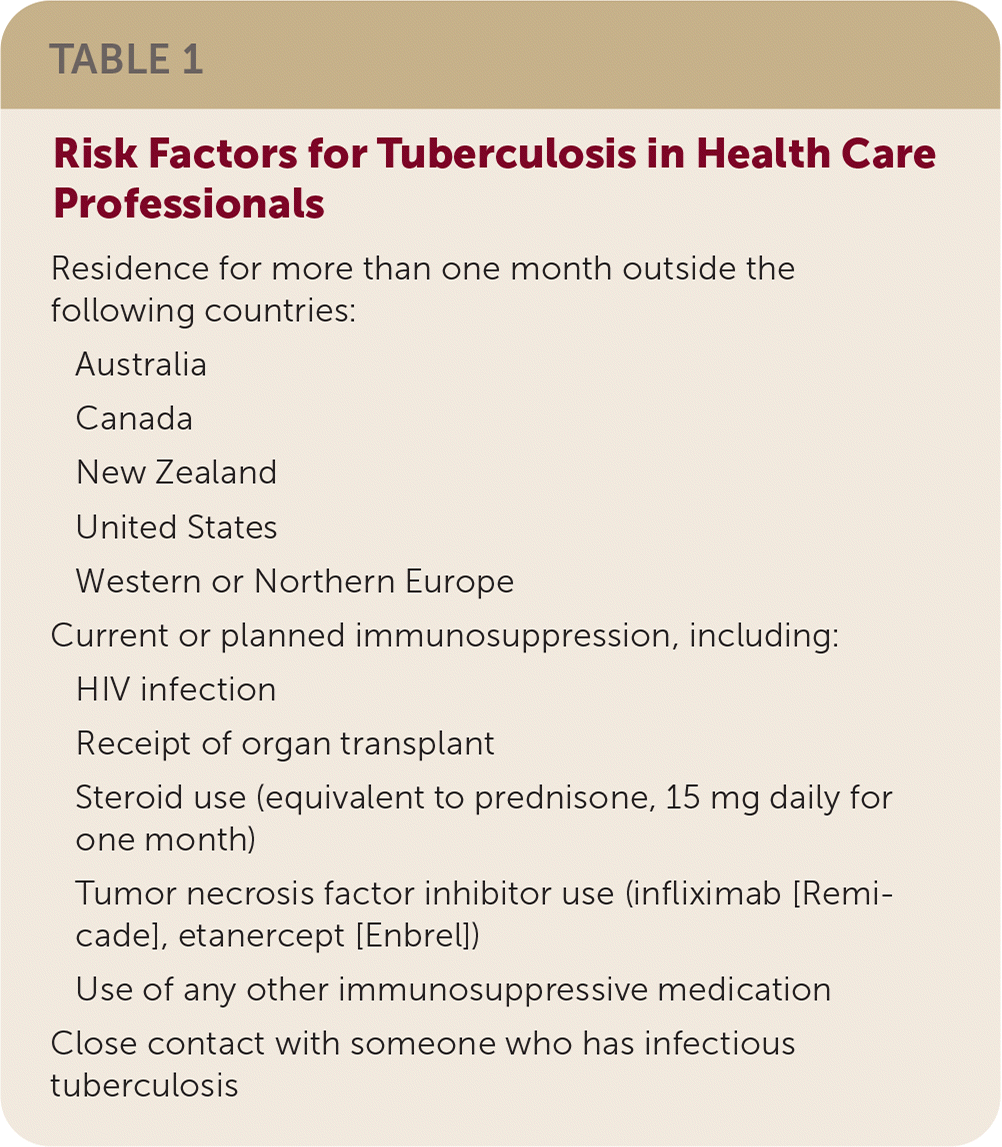
Am Fam Physician. 2020;101(5):312-313
Author disclosure: No relevant financial affiliations.
Key Points for Practice
• Health care professionals should be assessed for TB risk with baseline TB testing and confirmation of positive results in low-risk patients.
• Health care professionals with LTBI are strongly encouraged to receive treatment.
• Routine serial TB testing is no longer recommended for health care professionals.
From the AFP Editors
Although U.S. health care professionals previously had a higher risk for tuberculosis (TB) and latent TB infection (LTBI) due to occupational exposure, this may no longer be true. The annual national TB rate in 2017 (2.8 per 100,000 population) shows a substantial decline, with a 42% decrease from 2005 and a 73% decrease from 1991. According to 1995–2007 surveillance data reported to the Centers for Disease Control and Prevention (CDC) and National Tuberculosis Controllers Association work group, TB incidence rates in health care professionals were similar to those in the general population.
Methods and Findings
Findings from a 2018 systematic review show that 3% of U.S. health care professionals have positive tuberculin skin test (TST) results and that 0.7% change from negative to positive with serial testing. For the interferon-gamma release assay (IGRA), 5% of health care workers test positive, and 4% change from negative to positive during serial testing. For those with positive initial testing, repeat testing was negative in 48% of cases by IGRA and 62% by TST. Whereas the clinical implications of conflicting test results have not been studied, none of the 63,975 U.S. health care professionals studied experienced TB disease.
Updated Recommendations
For health care professionals without documented previous LTBI or TB disease, TB screening includes TB risk assessment, symptom evaluation, and TB testing for Mycobacterium tuberculosis infection by IGRA or TST. The CDC does not differentiate between IGRA and TST as the preferred test.
BASELINE (PREPLACEMENT) SCREENING AND TESTING
Baseline TB screening for all U.S. health care professionals includes testing with IGRA or TST and individual risk assessment. Increased risk for TB disease occurs if a person has any of the conditions listed in Table 1.

| Residence for more than one month outside the following countries: |
| Australia |
| Canada |
| New Zealand |
| United States |
| Western or Northern Europe |
| Current or planned immunosuppression, including: |
| HIV infection |
| Receipt of organ transplant |
| Steroid use (equivalent to prednisone, 15 mg daily for one month) |
| Tumor necrosis factor inhibitor use (infliximab [Remicade], etanercept [Enbrel]) |
| Use of any other immunosuppressive medication |
| Close contact with someone who has infectious tuberculosis |
Risk assessment and symptoms guide response to positive IGRA or TST results. In a low-risk patient without symptoms, a positive test should be confirmed with a second test. This recommendation is consistent with the 2017 TB diagnostic guidelines of the American Thoracic Society, Infectious Diseases Society of America, and the CDC.
POSTEXPOSURE SCREENING AND TESTING
Health care professionals who were exposed to a patient with active TB without adequate personal protection should have a symptom evaluation and testing. An IGRA or a TST should be performed in those without documented evidence of previous LTBI or TB disease. Health care professionals with documented previous LTBI or TB disease do not require testing after exposure, but they should be clinically evaluated. A subsequent test, preferably the same type used for the initial testing, should be performed eight to 10 weeks after the original negative test.
SERIAL SCREENING AND TESTING
U.S. health care professionals without LTBI should not undergo routine serial TB screening or testing after baseline without known exposure or evidence of ongoing TB transmission. Health care facilities can consider serial TB screening of certain groups (e.g., pulmonologists, respiratory therapists) at increased exposure risk or in settings where transmission has previously occurred.
Health care facilities should annually educate health care professionals about TB, including risk factors, signs, and symptoms, and should encourage discussion between health care professionals and their primary care physician and/or occupational health clinician about occupational or nonoccupational TB exposure.
EVALUATION AND TREATMENT
A symptom evaluation and chest radiography should be performed on health care professionals who have a new positive test result (after confirmation if at low risk) to assess for TB disease.
Unless the health care professional is symptomatic or beginning LTBI treatment, repeat radiography is not warranted in those with positive TB testing and a normal chest radiograph. If TB disease is suspected, the local public health department should be notified immediately.
Health care professionals with LTBI but no previous treatment should be strongly encouraged to complete treatment with a recommended regimen, including short-course options, unless a contraindication exists. If health care professionals do not complete the LTBI treatment, they should be monitored annually with symptom evaluation to reevaluate the risks and benefits of treatment and to detect possible early evidence of TB disease.
Summary
The new CDC guidelines add a risk assessment to initial testing of health care professionals so that low-risk individuals with positive test results receive confirmatory testing. For potential exposures, only patients without previous LTBI should receive immediate and repeat testing at eight to 10 weeks after exposure. Routine serial testing of health care workers is no longer recommended. Recommendations for treatment and monitoring of patients with LTBI and provider education are unchanged from previous guidelines.
Guideline source: Centers for Disease Control and Prevention
Evidence rating system used? Yes
Systematic literature search described? Yes
Guideline developed by participants without relevant financial ties to industry? No
Recommendations based on patient-oriented outcomes? Yes
Published source: MMWR Morb Mortal Wkly Rep. May 17, 2019;68(19):439–443
